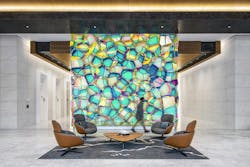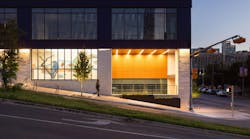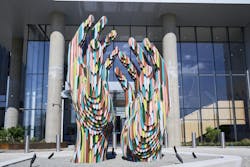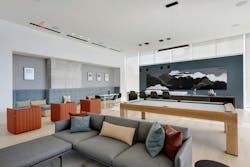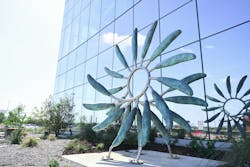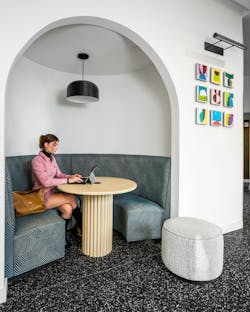The ROI of art in CRE: 5 proven strategies that deliver measurable returns
The commercial real estate landscape has fundamentally shifted. Your clients aren't just asking for functional spaces anymore—they're demanding environments that drive performance, attract talent, and deliver measurable business outcomes. Yet many AEC professionals still view art as an afterthought, a "nice-to-have" budget line item that gets cut when costs need trimming.
This perspective is costing you projects and limiting your value proposition.
The Business Case for Art Integration
Recent research reveals compelling data that should reshape how you approach art in commercial projects. According to a 2024 Gensler survey of 16,000 office workers globally, high-performing workplaces provide twice as much access to arts and culture as low-performing ones. More striking: areas adorned with murals experienced a 30% boost in weekend pedestrian activity compared to mural-free zones, while violent crime decreased by 28% during a period when crime was rising in most parts of the city.
For your companies and CRE developers, these aren't just feel-good statistics—they're bottom-line impacts that directly affect lease rates, retention, and property values.
5 Proven Strategies to Maximize Art ROI in Your Projects
1. Position Art as Critical Infrastructure, Not Decoration
Stop presenting art as an aesthetic enhancement and start positioning it as performance infrastructure. The University of Exeter found that workers in places with art and plants were 32% more productive, had 45% better well-being, and were 60% more engaged than workers in spaces without these features. A 32% productivity increase in a 100-person office earning average salaries of $75,000 translates to approximately $2.4 million in additional annual productivity value.
Include art specifications in your base building systems documentation alongside HVAC and lighting—as essential components for occupant performance. Present art budgets as critical infrastructure investments, not decorative enhancements.
2. Front-Load Art Planning to Avoid Cost Escalation
The biggest mistake AEC teams make is treating art as a final phase consideration. Art consultants must be knowledgeable about interior design, architecture, and construction to work seamlessly with development teams. When you engage art consultants during schematic design rather than construction administration, you avoid the costly retrofitting and change orders that plague projects where art becomes an afterthought.
Planning power, mounting systems, and security during design development prevents the installation complications and budget overruns common when art is considered only after construction documents are finalized. Smart teams integrate art requirements into their base building specifications from the start.
3. Leverage Art for Expedited Permitting and Community Relations
Public art has a proven track record of reducing crime and increasing foot traffic—data you can use to strengthen community engagement and streamline approval processes. When you propose public art components that address municipal goals around safety, economic development, and cultural enrichment, you create alignment with municipal priorities that can smooth the approval process.
Document these benefits in your permit applications and community presentations. Municipal leaders understand that art-enhanced developments become community assets rather than potential problems, reducing the likelihood of community opposition that can delay projects.
4. Design Art Programs That Generate Ongoing Revenue
Think beyond one-time installations. Well-made artwork can last decades or even centuries, while office floors need replacement every 3-10 years. Design rotating exhibition spaces, digital art displays, and programmable areas that can generate rental revenue and keep spaces fresh. Include infrastructure for changing displays in your base building design.
This approach transforms art from a capital expense into a revenue-generating amenity that keeps properties competitive over time. Miami Design District's strategic integration of public art helped transform it from a neglected warehouse district to a global luxury retail destination, demonstrating how art can drive long-term property value and tenant attraction.
5. Quantify and Document Performance Metrics
TIAA's new corporate hub in Frisco exemplifies performance-driven design that delivers measurable results. When Teachers Insurance and Annuity Association of America consolidated two North Texas offices and another in Denver into a new 15-story, 500,000 square-foot tower at The Star development, they invested in employee-informed design from day one. A survey of about 600 employees helped shape the building's layout, furniture and amenities, creating what Curtis Bodison, TIAA's head of global corporate services, calls a workplace that allows associates to "win the commute."
The results speak for themselves: Dallas Business Journal named it one of "DFW's Coolest Offices," recognizing workplaces that fuel collaboration and innovation. Art + Artisans curated over 150 artworks for the property, creating an environment where art doesn't just decorate—it actively supports the company's mission of serving educators. The exterior sculpture represents the teachers who make up TIAA's core customer base, while interior pieces reflect Texas landscapes from Big Thicket National Park to the Hill Country.
Establish baseline metrics before art installation: foot traffic patterns, dwell times, leasing velocity, and tenant satisfaction scores. Measure again 6-12 months post-installation. This documentation becomes a powerful differentiator when competing for future projects, as sophisticated developers increasingly understand the connection between environmental design and performance outcomes.
Making the Business Case
The evidence is overwhelming: thoughtfully integrated art delivers measurable returns on investment. Blink, Cincinnati's public art festival, attracted 2 million attendees and generated over $126 million in direct economic impact in just four days. Your clients are competing for talent in the tightest labor market in decades while fighting to justify return-to-office mandates and premium lease rates in competitive markets.
Art isn't a luxury—it's a competitive necessity that drives occupancy, productivity, and property values. The question isn't whether your projects should include art. The question is whether you'll lead your clients toward performance-driven art integration or let competitors capture that value.
About the Author
Jennifer Brener Seay is the Founder and CEO of Art + Artisans. She has curated over 20M sf of art in commercial real estate, and helped clients create impactful spaces for over two decades. For more information, please visit artplusartisans.com.
